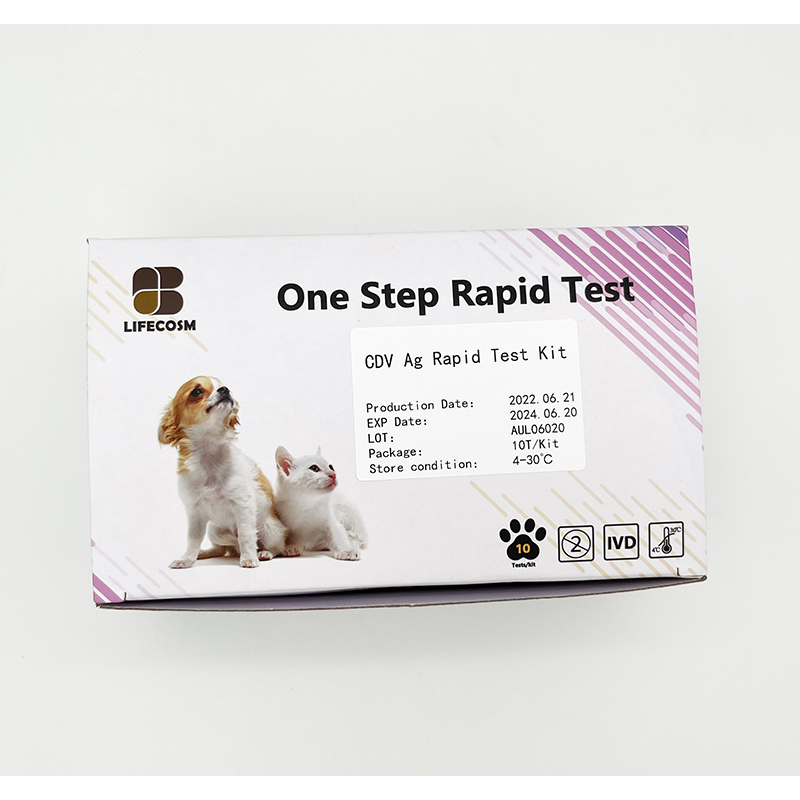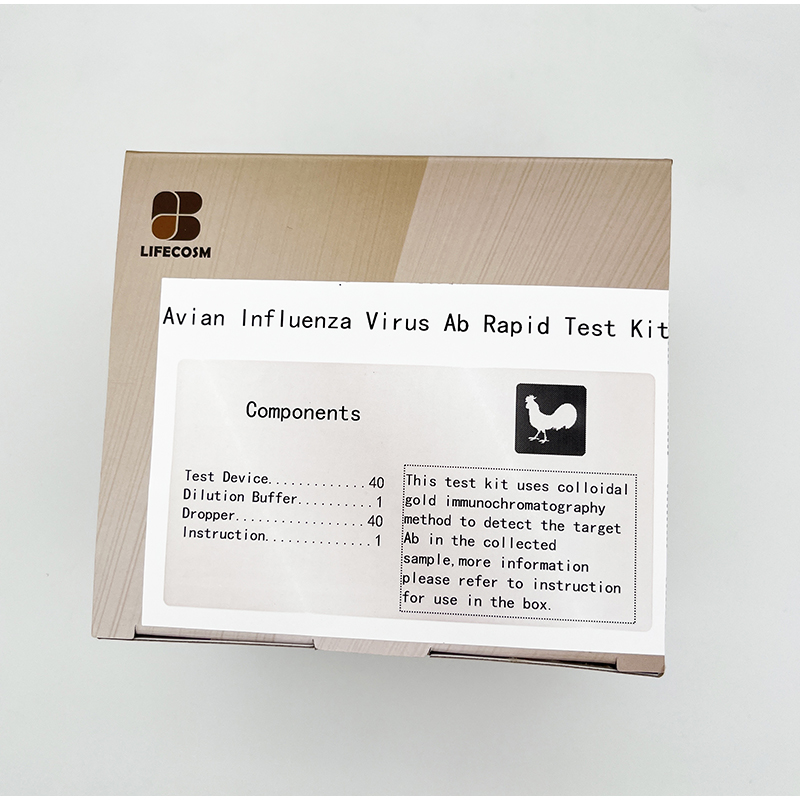
Products
Best quality Common Eu Rapid Antigen Test List - Lifecosm Brucella Ab Test Kit veterinary diagnostic test – Lifecosm
Best quality Common Eu Rapid Antigen Test List - Lifecosm Brucella Ab Test Kit veterinary diagnostic test – Lifecosm Detail:
Brucella Ab Test Kit
| Brucella Ab Test Kit | |
| Catalog number | RC-CF11 |
| Summary | Detection of specific antibodies of Brucella within 10 minutes |
| Principle | One-step immunochromatographic assay |
| Detection Targets | Brucella antibodies |
| Sample | Canine, bovine and Ovis Whole Blood, Plasma or Serum |
| Reading time | 10 ~ 15 minutes |
| Sensitivity | 91.3 % vs. IFA |
| Specificity | 100.0 % vs. IFA |
| Limit of Detection | IFA Titer 1/16 |
| Quantity | 1 box (kit) = 10 devices (Individual packing) |
| Contents | Test kit, Tubes, Disposable droppers |
|
Caution |
Use within 10 minutes after openingUse appropriate amount of sample (0.01 ml of a dropper)Use after 15~30 minutes at RT if they are stored under cold circumstances
Consider the test results as invalid after 10 minutes |
Information
The genus Brucella is a member of family Brucellaceae and includes ten species which are small, non-motile, non-sporing, aerobic, gram-negative intracellular coccobacilli. They are catalase, oxidase and urea positive bacteria. Members of the genus can grow on enriched media like blood agar or chocolate agar. Brucellosis is a well-known zoonosis, present in all the continents, but with greatly varying prevalence and incidence, in the animal and human populations. Brucella, as facultative intracellular parasites, colonize many species of social animals in a chronic, possibly permanent way, perhaps for their whole lifetime.

Brucella colony appearance
Transmission
Brucella species are usually transmitted between animals by contact with the placenta, fetus, fetal fluids and vaginal discharges of an infected animal. Most or all Brucella species are also found in semen. Male can shed these organisms for long periods or lifelong. Some Brucella species have also been detected in other secretions and excretions including urine, feces, hygroma fluid, salvia, milk and nasal and ocular secretions

Symptoms
♦ In cows
There is no effective way to detect infected animals by their appearance. The most obvious signs in pregnant animals are abortion or birth of weak calves. Milk production may be reduced from changes in the normal lactation period caused by abortions and delayed conceptions. Other signs of brucellosis include an apparent lowering of fertility with poor conception rates, retained afterbirths with resulting uterine infections, and (occasionally) enlarged, arthritic joints.
♦ In dogs
In dogs, the Brucellosis bacteria normally settle down in the genitals and the lymphatic system, but it is possible for it to spread to the kidneys, eyes and the intervertebral disc as well. When Brucellosis infects the intervertebral disc, the result is discospondylitis. In dogs, symptoms from the reproductive organs are common. Male dogs can for instance develop scrotal and testicular inflammations, while female dogs can have miscarriages. Fever is uncommon, but the pain associated with Brucellosis can make the dog weak. If the disease spreads to kidneys, eyes or the intervertebral disc symptoms can begin to show from these organs.
♦ In pigs
The time between infection and the appearance of clinical signs of disease can range from about 1 week to 2 months. Signs that a herd has become infected are mainly those of reproductive failure – abortions, returns-to- service after mating and the birth of weak or stillborn piglets. Some sows may develop an infection of the uterus and show a vaginal discharge. Infected boars may develop swollen, inflamed testicles. Both sexes may become lame with swollen joints and/or develop signs of incoordination and hind leg paralysis.
Diagnosis
Isolation and identification of agent
Brucella species can be recovered from numerous tissue and secretions, particularly fetal membranes, vaginal secretions, milk(or udder secretions), semen, arthritis of hygroma fluids, and the stomach content, spleen and lung from aborted fetuses. Most Brucella species from colonies within a few days on selective media. When the plates are viewed in daylight through a transparent medium, these colonies are translucent and a pale honey color. When viewed from above, colonies appear convex and pearly white. Later colonies become larger and slightly darker.
Nucleic acid Method
PCR is a convenient tool for the diagnosis of brucellosis. Numerous PCR- based assays have been developed for the identification of Brucella to improve diagnostic capabilities. A genus-specific PCR assay is adequate to the simple identification of Brucella.
Serological diagnosis
There are many serological tests. Serological tests commonly used to test individual cattle or herds include the buffered Brucella antigen test, complement fixation, indirect or competitive enzyme-linked immunosorbent assays(ELISA) and fluorescence assay.
Product detail pictures:



Related Product Guide:
We support our purchasers with ideal high-quality merchandise and significant level company. Becoming the specialist manufacturer in this sector, we now have received loaded practical encounter in producing and managing for Best quality Common Eu Rapid Antigen Test List - Lifecosm Brucella Ab Test Kit veterinary diagnostic test – Lifecosm , The product will supply to all over the world, such as: Bhutan, Norway, Indonesia, Business philosophy: Take the customer as the Center, take the quality as the life, integrity, responsibility, focus, innovation.We will provide professional, quality in return for the trust of customers, with most major global suppliers,all of our employees will work together and move forward together.
Product variety is complete, good quality and inexpensive, the delivery is fast and transport is security, very good, we are happy to cooperate with a reputable company!


